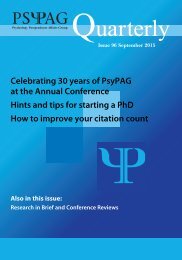Social Psychology Special Issue
XFCu7
XFCu7
You also want an ePaper? Increase the reach of your titles
YUMPU automatically turns print PDFs into web optimized ePapers that Google loves.
Charlotte R. Pennington<br />
Limitations of stereotype threat and<br />
future directions<br />
Despite the success of stereotype threat<br />
research over the years, researchers have<br />
argued that studies have been based upon<br />
small and non-representative samples in laboratory<br />
settings, thus, raising concerns about<br />
the theory’s external validity (Brown & Day,<br />
2006). Recent research, however, has begun<br />
to document the applied efficacy of stereotype<br />
threat. For example, in a naturalistic<br />
study, Rothgerber and Wolsiefer (2013)<br />
demonstrated that females’ chess ability was<br />
undermined by the presence of a male<br />
component. Furthermore, stereotype threat<br />
has been found to occur in job promotion<br />
contexts, with African Americans underperforming<br />
in comparison to Caucasians on a<br />
written knowledge test (Chung et al., 2010).<br />
Such findings add weight to the assertion that<br />
stereotype threat is a very valuable construct<br />
for understanding and reducing real-world<br />
achievement (Aronson & Dee, 2011).<br />
<strong>Issue</strong>s have also been raised regarding<br />
the ecological validity of stereotype threat<br />
primes. In real world testing environments,<br />
it is unlikely that educators would indicate to<br />
test takers that they were examining, or<br />
expecting to find, race differences on a test<br />
of cognitive ability (Brown & Day, 2006).<br />
Similarly, it is unlikely that a teacher would<br />
explicitly state a negative stereotype<br />
regarding women’s mathematical ability<br />
before a maths test commences. Nevertheless,<br />
research has suggested that the pervasive<br />
nature of negative cultural stereotypes<br />
may be ingrained in the educational system,<br />
and may be transferred to students by their<br />
parents and teachers (Gunderson et al.,<br />
2012). In a similar vein, studies have shown<br />
that seemingly benign factors in the testing<br />
environment, such as the gender composition<br />
of the classroom, may elicit stereotype<br />
threat effects, and have demonstrated that<br />
these effects may be heightened when a<br />
stereotype is implicitly primed (c.f. Nguyen<br />
& Ryan, 2008, for meta-analysis). As such, it<br />
is plausible that when targeted group<br />
members take standardised ability tests, such<br />
as in educational admission or employment<br />
selection contexts, their performance may<br />
be undermined when they encounter cues<br />
that evoke the salience of a discredited social<br />
identity.<br />
The past two decades of research have<br />
advanced our understanding of how negative<br />
societal stereotypes can hamper achievement<br />
and limit opportunities for success.<br />
A closer look at the literature, however,<br />
reveals that stereotype threat has been traditionally<br />
perceived as a singular construct,<br />
experienced similarly across individuals,<br />
groups and situations (Shapiro & Neuberg,<br />
2007). That is, stereotype threat is viewed<br />
typically as a threat to social identity; a situational<br />
predicament which occurs when individuals<br />
perceive their social group to be<br />
devalued by others. Nevertheless, targeted<br />
individuals may also experience stereotype<br />
threat when they perceive that their<br />
performance to be self-characteristic of<br />
personal ability (e.g. Steele & Aronson,<br />
1995). As such, previous research has overlooked<br />
the distinction between the self and<br />
the social group as potential targets of<br />
stereotype threat, although most stereotype<br />
threat manipulations focus on one or the<br />
other. More recently, Shapiro and Neuberg<br />
(2007) developed the multi-threat framework,<br />
which acknowledges the existence of<br />
multiple stereotype threats that operate<br />
through qualitatively distinct pathways.<br />
According to this theory, individuals may<br />
experience a self-as-target stereotype threat<br />
when they apprehend that stereotype-relevant<br />
performance will reflect poorly on one’s<br />
own abilities. Conversely, individuals may<br />
experience a group-as-target stereotype<br />
threat when they perceive their performance<br />
to confirm, or reinforce, the view that their<br />
social group lacks a valued ability. Moreover,<br />
this theory acknowledges that different experiences<br />
of stereotype threats may emerge<br />
due to concerns about who will evaluate<br />
performance (i.e. the self, outgroup others,<br />
or ingroup others. Nevertheless, to date, no<br />
research has empirically examined the<br />
effects of these distinct stereotype threats on<br />
12 PsyPAG Quarterly



